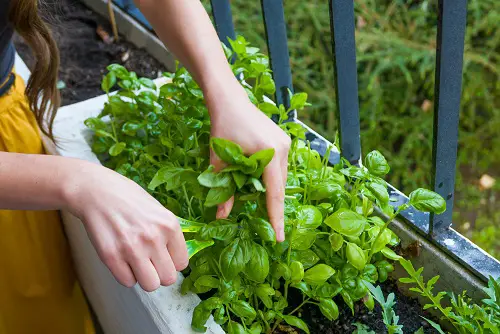Confused about Why and How To Prune Herbs? Here’s Everything About Pruning Herbs that will guide you into doing it the right way!

If you are not sure about Why and How To Prune Herbs, then don’t worry. Here’s a detailed guide on Everything About Pruning Herbs to help you out!
Here are the Best Herbs that Attract Money
Why Prune Herbs?
- The herb garden will show abundant growth if you prune it routinely.
- Pruning also encourages bushier and fresh growth and avoids flowering and seeding.
- To keep the plants compact and in shape. It’ll also promote good air circulation and save space for other herbs.
- For availability of fresh herbs in the growing season or storing them for future use.
- The trimmings can be used for propagating new plants.
Check out the Best Herbs for Protection here
Types of Herbs and Pruning
While it’s true that pruning herbs is beneficial, but excess pruning can be detrimental. Cut back the plant too much, and it’ll not grow the same again. It’s best to avoid cutting more than one-third of the plant at one time.
You can give the plant light pruning or hard pruning—it entirely depends on the type of herb you’re growing.
Here are DIY Hanging Indoor Herb Gardens
Pruning Herbaceous Herbs

Herbs such as basil, stevia, oregano, cilantro, chives, lemon balm, and mint are herbaceous plants and do not have woody stems. Many of these plants do not survive harsh winters (unless you live in a mild climate) and grow with vigor only in springs and summers—they are technically annuals.
These plants are most suitable for light pruning. Don’t prune these herbs heavily, trim mainly from the top, skipping the sides. The herbs will grow bushier and more productive with each light pruning cycle.
- Simply pinch back the top part along with the first set of leaves, just above the leaf node. This pinching will remove the terminal bud and allow the non-growing lateral buds to grow, and the plant will become fuller, forming more stems and side shoots.
- You can trim more growth but with the point in mind—always cut above the leaf node or lateral buds (emerging little stems).
- This pruning can be done anytime or when you’re harvesting these herbs; instead of only picking the leaves, apply this method.
- Don’t over-prune these herbs and leave them balanced. Usually, regular harvesting is enough.
- Also, snip off the blooms as soon as they appear. It’ll keep the energy directed toward more foliage growth.
Check out Delicious Herbs for Perfect Pasta here
Evergreen Herbs

Rosemary, lavender, thyme, bay, and sage are some herbs that show robust growth without much care and require hard pruning. In other words, the evergreen or perennial herbs in your climate require hard pruning.
Learn How to Make a Windowsill Herb Garden here
Best Time to Prune Herbs
The best time for pruning such herbs is at the beginning of the growing season when the herbs start to grow. Wait until you see new growth, young leaves, and buds forming.
Perennial herbs can go on without pruning. But, to maintain their shape and size and to get new and more flavorful foliage, it’s required.
- Cut back all the dead, decaying, and crossing woody stems. This much pruning is fine for a healthy plant.
- However, if your herb is leggy or overgrown, cut back about one-third of the plant.
- Do not prune these herbs when they become dormant or when they are at the end of the growing season. Cutting this time will spurt new growth, while the plant is getting ready to dormant.
- Pruning once a year is sufficient for these herbs. You can also perform slight pruning once they flower.
Here are Rosemary Benefits Backed by Science
Pinching Herbs

No matter the type of herb, pinching a young plant prevents leggy growth and make it bushier, and improves its structure from the beginning. For this, pinch the stem tips and the first set of leaves.
- Pinch off the growing tips when the plant is 4-5 inches tall and has grown a few sets of true leaves. This tutorial video here will help you.
- The more explanatory version—find a pair of buds; you’ll usually spot them just above the point where the leaf joins the stem.
- Now easy, remove the growth above the buds and leaves using sharp shears or fingernails. This process will activate those buds, and your plant will become bushier.


